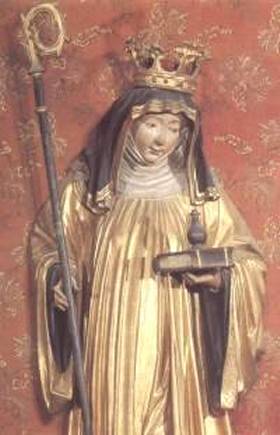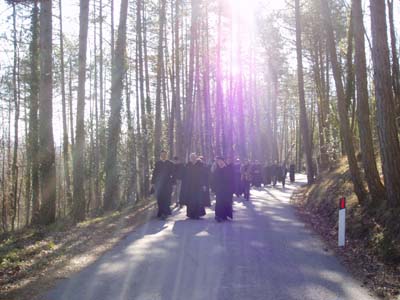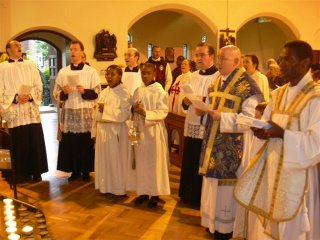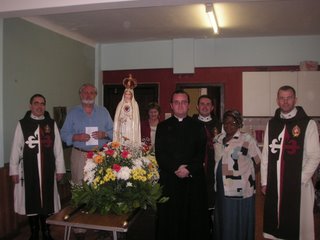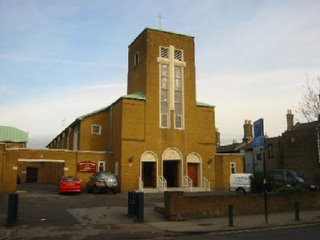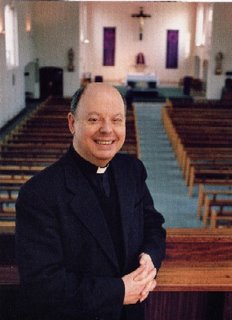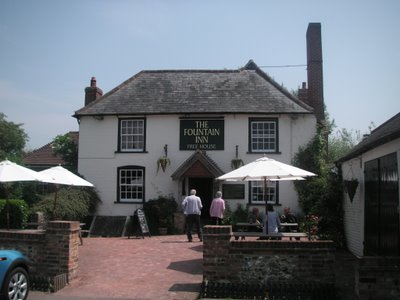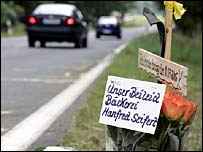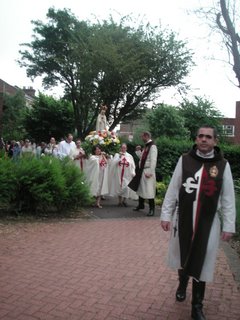 Here's my sermon from last night - which may not mean much if you've never been to the National Shrine of Our Lady of Willesden:
Here's my sermon from last night - which may not mean much if you've never been to the National Shrine of Our Lady of Willesden:I’m sure you’ve all had a chance to admire our
new sign outside the entrance of this church. At the centre are three figures. In the middle, as you would expect, is Mary, the Mother of God, who we venerate as the Protector of London under the ancient title, ‘Our Lady of Willesden.’ On either side of her kneel representatives of the many thousands of pilgrims who have made their way to her shrine here at Willesden over the centuries. They’re not just any ordinary pilgrims, but two men who have since been canonised by the Church: SS Thomas More and Josemaria Escriva.
We can take great pride in this. Willesden may not have the picturesque setting, quaint tea-shops or even the richness of tradition that a shrine like Walsingham has – but this is the ‘shrine of saints.’ These two saints are indeed, at first glance, rather different from each other – a sixteenth century English Lord Chancellor and martyr, and a twentieth century Spanish priest and founder of Opus Dei. They came from different backgrounds and followed different vocations. Yet there are two things, at least, which they have in common.
First of all, and most obvious, is their love for Our Lady. St Thomas More often made the pilgrimage to Willesden, both to see his adopted daughter, Alice, who lived nearby, and to pray before the ‘Black Madonna’ at the church of St Mary (about twenty minutes walk from here). His familiarity with the shrine is expressed in some of his polemical writings where he cites the example of Willesden in defending the practice of pilgrimages against the attacks of the early Protestant reformers. More’s last visit to the shrine was in April 1534, just before his arrest, trial and execution. We can imagine the saint praying for strength and perseverance at the foot of the statue – and we know from the history books that his prayers were answered.
St Josemaria also had a great Marian devotion and ended most of his talks and reflections with a reference to the Mother of God. He often repeated the words, ‘All with Peter to Jesus through Mary’ – for Escriva, devotion to Mary not only brought the faithful to her Divine Son, but also made them ‘feel closer to the other members of the mystical body and more united to its visible head, the pope.’
There is a story that, as he walked around the streets of Madrid in the early days of Opus Dei, he would always stop at any street shrine of Our Lady that he passed. There was one in particular, located near the royal palace, before which he would sometimes kneel in the street for up to an hour, causing passers-by to think he was a madman! As Opus Dei grew, St Josemaria made many pilgrimages to shrines around the world. He visited this very church on two occasions, during his trips to London. On 15th August 1958 he made a private pilgrimage here and re-consecrated Opus Dei to the Name of Mary (as he did every year). He returned on 17th August 1962, this time with his future successor, the Servant of God Alvaro del Portillo. They recited the Holy Rosary and bought some images of the statue to distribute to members of Opus Dei in Hampstead.
Our two saintly pilgrims were not only faithful sons of Mary but also pioneers of the lay apostolate – both teach us about being a Christian in the world, one through his writings and vision, the other by his example in life and on the scaffold.
As a priest, St Josemaria’s principal concern was to help people become saints in the midst of the modern world. He once said: ‘Your duty is to sanctify yourself. Yes, even you. Who thinks that this task is only for priests and religious? To everyone, without exception, Our Lord said: Be ye perfect, as my heavenly Father is perfect.’ And so, in 1928, he founded Opus Dei to help men and women sanctify their work and themselves ‘in the world.’ Today it has well over 80,000 members. Tonight we’re delighted to welcome Mgr Nicholas Morrish (Regional Vicar of Opus Dei for Great Britain), Fr Joe Evans and other members of the Prelature who join us as we bless our sign board, which is thought to be the first public image of St Josemaria in this country.
It is little surprise that St Thomas More is one of the patrons of Opus Dei. Escriva admired More because he faithfully followed the dictates of his conscience and the teachings of the Church while living in the world as a husband, father, thinker and politician. He tried to balance the duties of citizenship with the duties of discipleship, but his ultimate witness was that the things of God always have primacy. Hence his famous last words that he was ‘the King’s good servant but God’s first.’
As well as blessing the new signboard, tonight we will bless a copy of our processional statue, which will be taken around the homes of Catholic Londoners. We also have amongst us a Pilgrim Statue of Our Lady of Fatima, blessed by the Servant of God, Pope John Paul II. As the image of Our Lady of Willesden makes its way around London, so the Heralds of the Gospel will take this statue around the country.
We pray that as these families take Our Lady into their homes, they will both honour her and learn to follow her. Mary stands apart as the Mother of God – a privileged, once-and-for-all vocation. As today’s saint, Anthony of Padua (known as the ‘Evangelical Doctor’ and the ‘Hammer of Heretics’), once said:
O inestimabilis Mariae dignitas! O inennarabilis gratiae sublimitas! O investigabilis misericordiae profunditas!
O inestimable dignity of Mary! O indescribable sublimity of grace! O incomprehensible depth of mercy! Has so much grace or mercy ever been given to an angel or man as has been given to the Blessed Virgin, whom God the Father wished to be the Mother of His Son?
But she also remains one of us, the first of the redeemed, a creature who leads the way for we who strive to follow. That’s why the imitation of Mary is the natural result of devotion to Mary. After all, the Queen of Heaven and Earth, the Immaculate Mother of God was a lay woman, living ‘in the world.’ Her life was not as picturesque as we might think; a life full of mundane domestic details; a life enveloped by silence; a life surrounded by poverty and sacrifice.
We can imitate her love, which was without limit. Love is not just about gushy feelings – it must flow into our actions. Mary’s love was not only expressed in words to the Angel Gabriel through her fiat, but was expressed in every moment of her life – even during the hard times, when she must have felt anything but sentimental. Her love extended to watching her Son carry the cross to Mount Calvary, where He died in agonising pain.
We can imitate her faithful obedience to the will of God. Our Lady says few words in the Gospels. She comes across as a listener, a contemplative in the world who ‘ponders what she doesn’t fully understand and asks about what she doesn’t know.’ Despite the prophecy of Simeon, Mary life was full of unexpected joys and sorrows, but even her darkest moments did not affect her obedience to God’s will. She did not live on the surface of events, where things can go so easily up and down – rather she was anchored in God, sheltering in the shade of the Almighty, confident that He would triumph in the end.
We can imitate her humility. St Josemaria said that ‘the mystery of Mary helps us to see that in order to approach God we must become little…To become children we must renounce our pride and self-sufficiency, recognizing that we can do nothing by ourselves.’ We can follow her by sanctifying and offering to God even the smallest details of our lives (whether it be at home, at college or at work).
We can imitate her orientation to Christ – not only her Son but also her Lord and her God. She leads us to Him – so beautifully expressed in the statue of Our Lady of Willesden, who presents the child Jesus to us, with His arms unstretched in blessing. She is the Hodegrita, the way-pointer; she points us to Him and says, ‘Do what He tells you.’
Perhaps tonight we’ve hit upon what makes Our Lady of Willesden such a distinctive shrine. The ‘spirituality of Willesden’ (if I might coin a phrase) is precisely this: to honour and imitate Mary and be led by her to Jesus in the midst of twenty-first century London. The presence of the shrine in a busy, cosmopolitan part of London witnesses to the fact that sanctity is possible in every walk of life, just as it was possible for Mary in Nazareth 2,000 years ago, just as it was possible for St Thomas More at the court of Henry VIII, just as it was possible for St Josemaria Escriva by founding Opus Dei. It is possible because of the grace and love of Almighty God. It is possible because of the intercession of Our Lady.
This evening, then, we follow in the footsteps of the saintly pilgrims to Willesden, St Thomas More and St Josemaria Escriva, and pray that we who make this pilgrimage will one day enter our Heavenly Homeland. We pray that, like Our Lady, we will turn towards her Son, Our Lord Jesus Christ. In the words of St Anthony of Padua, we pray:
We ask you, Our Lady, you who are called the morning star,dispel with your light the thick fog of allurements to evilwhich fill our souls. Like the light of the moon, replenish our emptiness, and dissipate the darkness of our sins, sothat we may attain the fullness of eternal life and the lightof never diminishing glory. With His help, who made you ourlight, and although born from you, gave you life. To Him be honour and glory from age to age. Amen.
Labels: Parish, Saints










